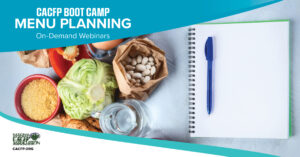Specialty 1
CN Labels & PFS Made Simple ($)
Understanding CN Labels and Product Formulation Statements (PFS) is essential for confidently meeting CACFP meal pattern requirements. We’ll equip you with practical tools to determine when and how to request documentation and sharpen your detective skills to identify discrepancies, ensuring everything is compliant and running smoothly.
Read MorePotato Palooza: Potatoes in CACFP Menus ($)
Get ready to “spud-tacularly” shake up your CACFP menu! We’re celebrating the mighty potato and exploring fun, creative ways to incorporate this versatile veggie into your meals.
Read MoreSoup’s On! A Warm Dive into Comfort Bowls
Join us for a cozy, flavorful journey into the world of soups! We’ll explore the secrets to crafting delicious and nutritious #CACFPCreditable soups that are perfect for any season. Learn tips and techniques to create soups that are both kid-friendly and packed with nutrients. Whether you’re new to soup-making or looking to expand your recipe repertoire, you will leave inspired and ready to serve up bowls full of goodness.
Read MoreAround the World: Cultural Food Resources
Explore ways to bring diverse flavors to your CACFP menus. A variety of resources are available to help you incorporate culturally relevant foods into your meal planning, allowing you to create menus that reflect and celebrate the communities you serve. Join us as we discuss the value of offering culturally inclusive meals and learn practical strategies for adapting menus to accommodate diverse tastes and traditions.
Read MoreBite-Sized Safety: Preventing Choking Hazards ($)
Children under the age of 4 are at high risk of choking while eating, as they’re still learning to chew properly and often swallow food whole. With their small airways easily blocked, it’s crucial to understand the risks posed by certain foods. Learn which foods to avoid or modify to reduce reducing choking hazards, which creates a safer meal time environment.
Read MoreFlavorful Cooking Using Herbs and Spices ($)
Tired of using the same seasonings for your meals? Enhance your culinary skills and create delicious, nutritious meals using a variety of herbs and spices. Get creative and learn how to develop your own DIY seasoning blends and what food pairs well with certain herbs and spices. Receive new recipe ideas to add to your menu.
Read MoreAdapting Menus for Special Diets ($)
Are you wondering how to navigate food allergies and create safe meals for the children in your care while participating in the CACFP? Learn the differences between various types of special diets and how to prepare these foods to meet CACFP guidelines. Know what a meal modification is, how to serve modified meals, and how to navigate through meal modification scenarios.
Read MoreWinter Wellness: Nurturing Immune Health in Kids ($)
Brace yourselves for the winter as chilly winds bring along the symphony of sniffles and coughs. Get ahead and help prevent colds and flus by giving an extra boost of health to those in your care through providing immune-supporting nutritional foods and activities. Learn how to convert your child care center and family child care home into a fortress of wellness by adding delicious recipes to your menu and fun games to keep their bodies in top working order.
Read MoreChoose Breakfast Cereals That Are Lower in Added Sugars
This webinar highlights the added sugars limit for breakfast cereals and how to identify cereals that meets this limit.
Read MoreMedical Statements, Milk Substitutions & Special Diets ($)
Have you ever received a parent’s or doctor’s note describing a meal modification or substitution to serve a child or adult in your care? Maybe you have felt confused or overwhelmed on how to modify the menu to ensure foods are safe to serve to a participant with a disability.
Read More






